Forecasts of future operating losses for private and public colleges and universities have appeared fairly frequently in recent months. When a newspaper article written by Times Union reporter Kathleen Moore showed up in my newsfeed, I took the time to read it.
Ms. Kathleen Moore wrote about a report from the SUNY System that was distributed to New York’s governor and legislature on December 29, 2023. According to Ms. Moore, the report notified the legislature that without increases in tuition or increases in state aid, the System’s deficit could balloon to $1 billion annually in a decade.
The Times Union article provides a decent overview of the highlights of the 80-page report. I opted to read the report and see if there were other highlights that Ms. Moore omitted that I thought noteworthy.
One would never know that there is a financial issue at all based on the opening of the executive summary of the report. In a paragraph captioned “SUNY is on the Move,” the authors note that with support from the governor, champions in the state legislature, the vision of the SUNY Board of Trustees, and the leadership of Chancellor John B. King, Jr., the system is “well-positioned to ensure its place as the nation’s leading statewide comprehensive public system of higher education.”
Strategic Priority Pillars
The System established four priority pillars to guide its future. These are:
- Student success,
- Research and scholarship,
- Diversity, equity, and inclusion,
- Economic development and upward mobility.
Financial Sustainability
Funding from the state is the system’s largest single source of funding. The state allocated $163 million in ongoing annual operating aid in 2023-24 plus commitments of $54 million more in each of the next two years. Community colleges are receiving $78 million in lost direct state tax support thanks to the 100% Community College Funding Floor.
According to the report, fiscal sustainability will require ongoing revenue increases and attention to operational efficiency. The report notes that SUNY’s economic impact in 2018 was $28.6 billion. Additionally, the report states that for every $1 invested by the state in SUNY, there is an $8.17 return.
The report acknowledges the state of New York’s “historic investments.” At the same time, the report indicates that with no investment in resources beyond the committed increases in the state of New York’s current financial plan, SUNY will face a $1.1 billion annual shortfall at the end of the decade.
To achieve fiscal sustainability, SUNY plans to:
- Implement its enrollment strategies.
- Optimize its academic portfolio.
- Collaborate operationally.
- Address structural imbalances.
Enrollment
SUNY believes that there is a place within its system for every New Yorker. Attending a SUNY college or university can “expand their horizons, better their lives, and cement their futures.”
For the first time in 10 years, SUNY’s total enrollment increased. While the increase was only a 1.1% gain, the report’s authors note that it was a huge leap to reverse longstanding trends. First-time undergraduate enrollment surged 4.3%.
SUNY has launched major new enrollment initiatives including:
- Enhanced marketing and bus trips for prospective students.
- Community college direct admissions.
- Personalized welcome letters to high school seniors.
- Strategic enrollment management plan support with emphasis on recruiting and supporting working adults.
- SUNY Match connects students not accepted into their top SUNY choice with admission at other SUNY campuses with programs in their area of interest.
- Transfer Match provides direct admission for students completing an associate degree.
- Out-of-State Tuition Match supports 19 campuses that choose to match the in-state tuition rate at neighboring states to increase out-of-state students.
- International Student Recruitment.
SUNY’s plans to accelerate enrollment gains depends on four components:
- Improving retention,
- Non-credit to credit conversion,
- Strengthening transfer pathways.
- Recruitment.
To improve student retention, SUNY plans to provide a comprehensive set of supports including:
- Tuition waivers to close any gap after need-based financial aid.
- Funding to defray commuting expenses.
- Textbook assistance.
- Early registration options to ensure selection of courses needed to fulfill requirements.
- More courses offered in summer and winter sessions.
- Personalized academic and career advising.
- Academic support and career development activities.
A systemwide Transfer Task Force has been launched to improve students’ ability to transfer between SUNY campuses.
Academic Portfolio Optimization
The System acknowledges that institutions must be nimble to meet student demand and expectations. The report recommends that campuses specialize and grow in their unique areas of advantage. High-cost programs should be developed collaboratively and regionally rather than individually and inefficiently.
Sadly, there was no mention how SUNY would operationalize the collaborative review of regional programs. Additionally, there was no mention of utilizing creative strategies such as online course sharing to lower costs and increase local offerings.
Operational Collaboration and Structural Imbalances
The System is committed to using its size, geographic reach, campus proximity, and unique assets to identify opportunities for collaboration, efficiencies, and improved services.
SUNY is making sure that all institutions have the resources they need to succeed. Several campuses have released blueprints for changes to enable financial sustainability and strong futures.
Digital Transformation
The legislature previously allocated $200 million for the digital transformation of SUNY’s IT infrastructure. The funding will enable:
- Upgrades to improve cybersecurity and essential infrastructure.
- Improved student experiences making it easier to enroll, transfer, and receive academic support.
- Expanded data capabilities to reduce costs to campuses and support student success.
- Standardized technologies across campuses enabling more effective collaboration.
In the report’s discussion about digital transformation, I did not read anything about creating or utilizing a course sharing platform, utilizing shared resources to build online courses, and/or utilizing resources to build Open Education Resources (OER ).
Research and Scholarship
No state university system would be content to leave out goals for increasing research and scholarship. SUNY is committed to being the leader in “cutting-edge graduate and undergraduate scholarship and research experience.” They are working to double research funding and “expand their footprint in innovation, start-ups, and new patents to spur workforce and economic development and social mobility.”
The report discusses increasing funding for research in Artificial Intelligence. This presages a recent announcement by New York’s governor regarding a proposed $400 million funding initiative for AI research allocated between public universities, private companies, and some non-profits. Not everyone concurs that this initiative will have favorable outcomes.
Diversity, Equity, and Inclusion
SUNY is committed to build and sustain inclusive environments and practices so that every member of the community feels welcomed. Areas of progress include:
- Responding to the U.S. Supreme Court’s race-conscious admissions decision with strategies to advance SUNY’s values.
- Strengthening general education requirements by including DEI content in each new student’s general education curriculum.
- Ensuring campus safety and an inclusive climate by standing up to racism, xenophobia, antisemitism, Islamophobia, and other forms of hate.
- Increasing faculty diversity.
- Strengthening leadership pipelines by increasing diverse executive education leadership.
- Supporting students with disabilities.
Economic Development and Upward Mobility
Major areas of progress include:
- Making targeted investments in workforce development in high-demand fields.
- Launched Workforce 2030 Task Force comprised of 11 community college presidents.
- Working to meet New York state’s healthcare workforce needs.
- Expanding internship opportunities with the goal to ultimately reach every SUNY student.
- Expanding registered apprenticeship opportunities.
- Scaling credit for prior learning.
- Expanding SUNY’s microcredential offerings.
- Advancing SUNY’s sustainability and climate action agenda.
Like other initiatives, the “scaling credit for prior learning” initiative utilizes people to scale and not technology. I am aware of several AI startups utilizing the power of AI to analyze learning objectives and assessments to recommend academic credit equivalencies. There are several companies offering products to help college students obtain relevant internships. There are more than a few companies that offer apprenticeships in partnerships with educational institutions. It appears that SUNY plans to scale up to do these internally, even if it is more costly and takes longer to implement.
Enrollment Challenges
SUNY acknowledges upfront that this fall was the first time overall enrollment had increased in more than a decade. While there are many initiatives to increase enrollment and retention, there are no specific enrollment targets cited in the report. There are two charts that I found interesting.
The first chart provides the total headcount change over the past decade for each of the state-operated four-year institutions. There are only nine institutions with growth over the past decade. There are 22 institutions with enrollment declines, 16 of which experienced double-digit percentage enrollment declines. The average number of students per program declined by 12 percent over the decade.
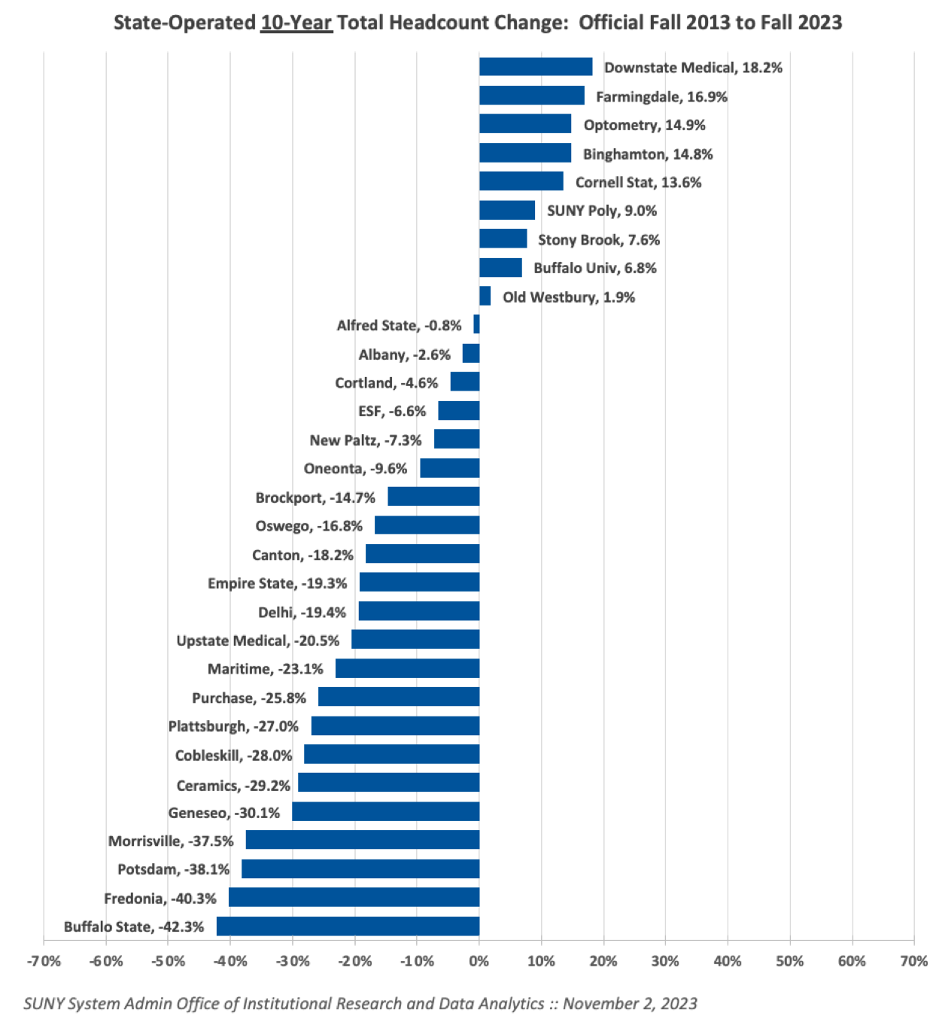
The second chart illustrates the percentage changes in enrollment at 30 community colleges over the past decade. Only one community college, Sullivan County, increased its enrollment over the period. The other 29 had decreased enrollments with nearly half (14) experiencing enrollment declines greater than 30 percent. The average number of students enrolled in a community college program declined by 47 percent during the decade.
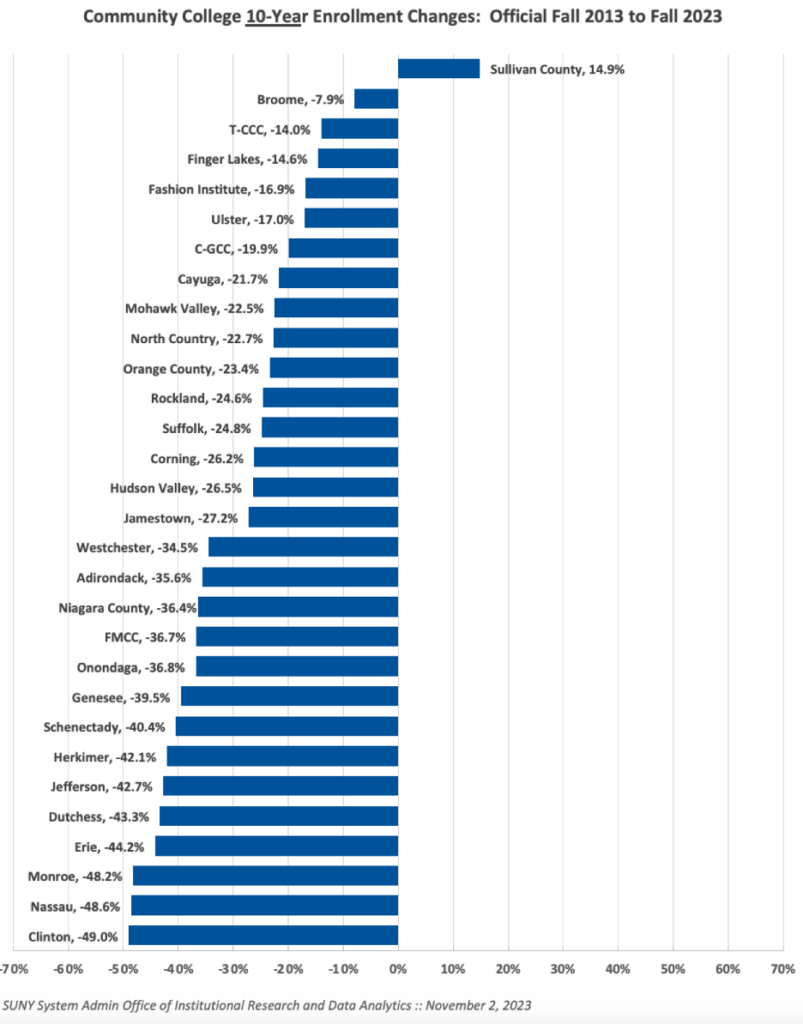
There are many details about the significant initiatives SUNY is implementing to increase enrollment. Many may be new to SUNY but are not new to institutions that have served working adult students. While there are historical numbers provided, I am surprised that there are no specific targets given that time and money are being spent to achieve this goal.
The report states that more courses will be offered during summer and winter terms to serve students. If SUNY’s institutions continue to offer credit courses only during Fall, Winter, Spring, and Summer, they will never capture the share of working adult students that they aspire to capture. Flexible terms starting at least 12 months of the year meet adult students’ needs. Almost all of the universities successful in enrolling tens of thousands of online, working adult students offer frequent semester starts.
Academic Portfolio Optimization
Given the decade long decline in overall enrollments at most institutions, it is no surprise that enrollments per degree program declined as well. The report indicates that portfolio optimization (evaluating the reasons why low enrollment programs are still offered) has not kept pace with declines in enrollment.
At the associate degree level, the number of programs with fewer than 10 students has increased in every discipline level. At the bachelor’s degree level, there are more programs with less than 10 students in the agriculture, education, and humanities areas. The share of programs with fewer than 10 students declined in the math, computer, information sciences, and personal, protective, and transportation services.
Over the next five years, SUNY expects to see their fastest enrollment growth in these fields:
- Health and health-related fields
- Math and computer and information sciences
- Architecture, engineering, and related technologies
- Business, management, and public administration
- Education
Education was a surprise to me given that its enrollments declined over the past decade, and so many teachers are choosing to leave the profession. It’s one of the areas with the highest number of programs with less than 10 graduates per year.
I reviewed the degree listing for SUNY at Albany. On the surface, it appears that they have too many bachelor’s programs with fewer than 10 graduates. The report states that the analysis of program optimization will occur at the regional level and not the institutional level. If the SUNY System is serious about this analysis, I might hire a firm like rpk Group to build a framework and reviewing a single region. SUNY can choose to follow the framework for additional reviews or continue to engage rpk Group.
Overall Investment
The report provides a very interesting chart that breaks out campus revenues for state-operated campuses and community colleges. Of note is that tuition and fees only comprise $2 billion of the $13.5 billion revenue total.
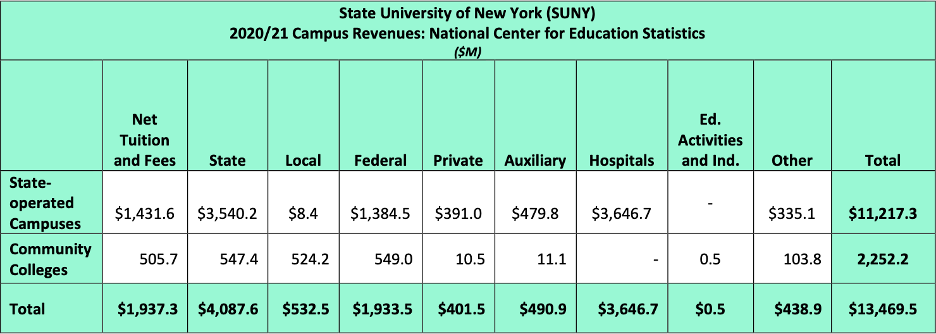
The significant investment by the state of New York in its higher education institutions provides New York residents with one of the lowest in-state tuition and fees in the U.S. In the chart below, the SUNY and CUNY Systems are only higher than the state of Florida’s public institutions.
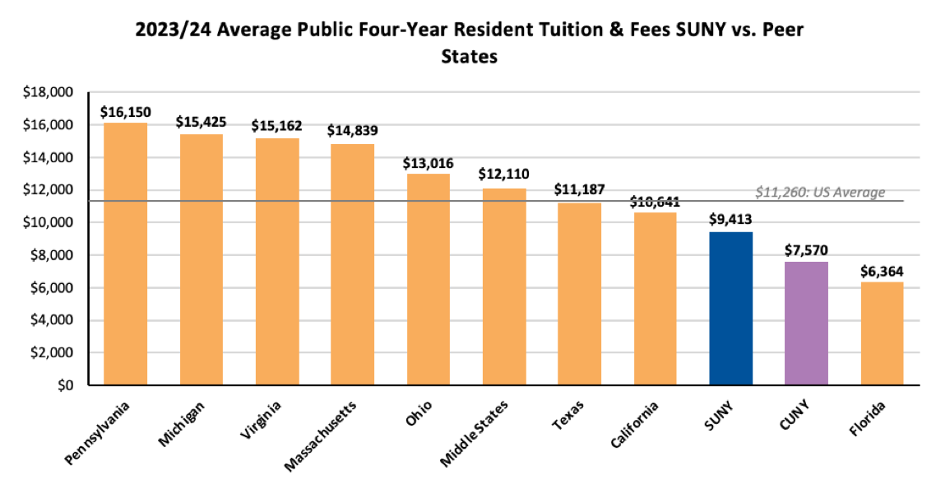
The state’s two-year colleges are competitive but not so much as the four-year institutions. In the chart below, Ohio, Virginia, Michigan, Florida, Texas, and California have subsidized two-year college fees less than SUNY.
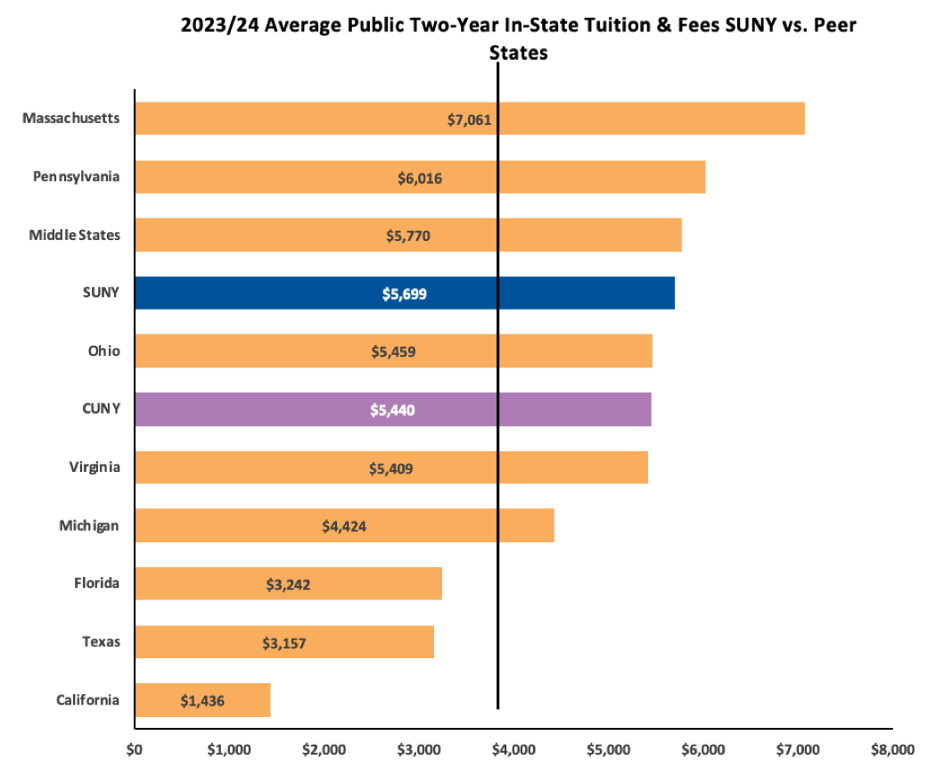
It’s my belief that the reason SUNY provided the charts illustrating its relative affordability compared to other states is to build support for “reasonable, predictable, ongoing increases in resources” that would reduce the projected annual shortfall of $1.1 billion to $89 million, a number that the report states could be managed through operational efficiencies.
The final few pages of the report provide several notable tables and charts explaining the additional resources that the state could provide that would reduce the $1.1 billion projected deficit. Included in those tables is a statement that the annual increase in enrollment will mirror the most recent which was 1.1 percent.
If all the initiatives listed in this report are successfully implemented, I would be disappointed with an annual enrollment increase of only 1.1%. Granted, there is a projected national enrollment decline due to a demographic shift in 2025-2026. At the same time, SUNY’s price points are very competitive. In addition, the micro-credentials initiative, the dual enrollment initiative, the transfer credit pathway initiative, and the initiative to convert competencies for non-credit courses to credits should be popular with students assuming SUNY can convert them at scale.
The report is well-written with a few missing pieces. If I were a member of a legislative committee or a member of the governor’s staff, I would ask for enrollment targets greater than 1% per annum. I would also ask SUNY leadership to conduct the program optimization reviews before approving additional funding.











